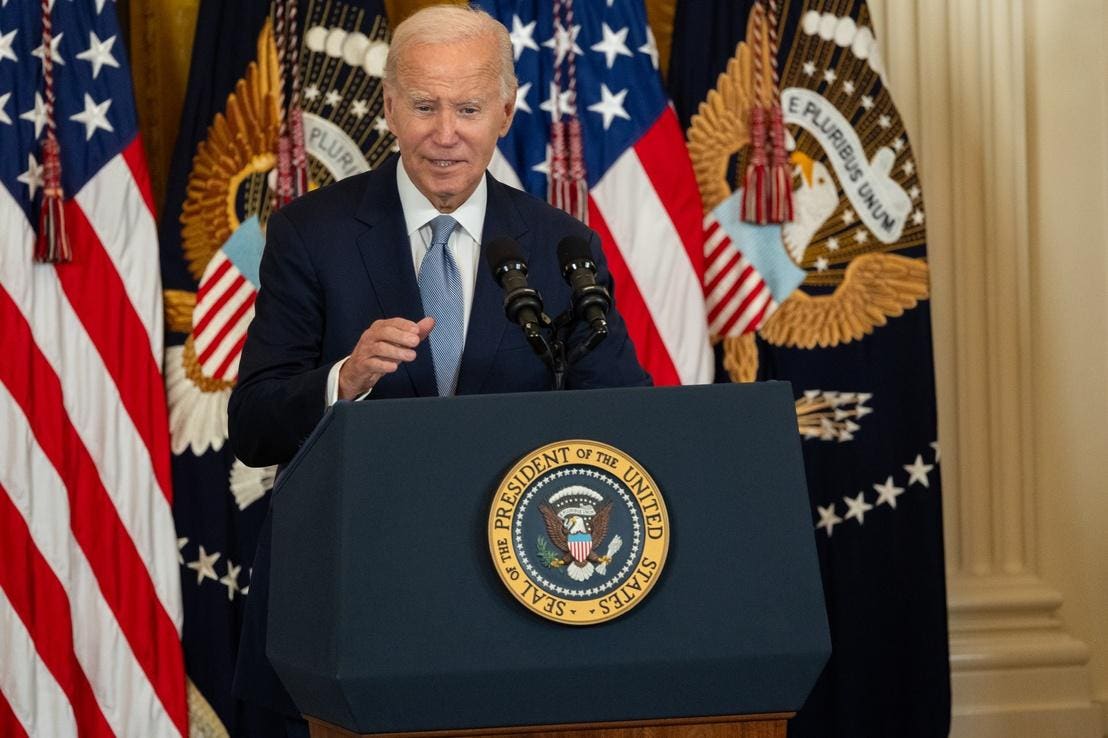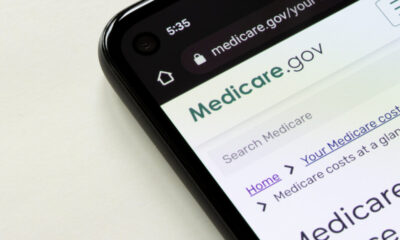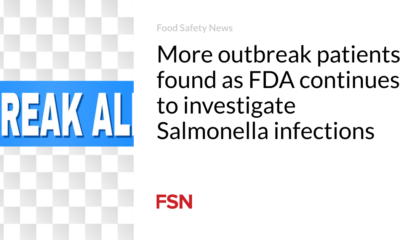Health
The $2,000 out-of-pocket drug cost cap helps millions of Medicare patients

WASHINGTON DC: President Biden speaks at the White House during an event on the implementation of the … [+]
The high out-of-pocket costs of cancer patients are sometimes described as “financial toxicity.” Already facing a life-threatening illness, financial toxicity can cause economic pain but also increase mental and emotional pain for American patients. One in five adults over 65 give up their prescriptions because of the costs. The Inflation Reduction Act’s cap of $2,000 on annual out-of-pocket drug expenditures will help alleviate the problem for Medicare beneficiaries.
As a consequence of the 2022 IRAMedicare’s outpatient drug benefit (Part D) began a substantial redesign this year when the 5% coinsurance requirement for patients was eliminated in the high-cost or so-called catastrophic phase. This means that there is currently a limit of $3,300 per year for annual out-of-pocket expenses on prescription drugs.
And as KFF explainsBy 2025, Medicare beneficiaries will pay no more than $2,000 out of pocket. This restructuring of the Part D benefit will do just that save thousands of dollars for people who take expensive drugs for cancer and other serious conditions.
If there had been a $2,000 limit on out-of-pocket spending on medications in 2021, 1.5 million Medicare beneficiaries enrolled in Part D plans would have saved money because they spent $2,000 or more out of pocket on drugs that year prescription drugs.
Over the course of several years, many more Part D participants will realize savings. A total of five million Part D participants had out-of-pocket drug costs of more than $2,000 in at least one year in the ten-year period between 2012 and 2021, while 6.8 million Part D participants paid $2,000 or more out of pocket in at least one year. one year since 2007, the first full year of the Part D program.
The year 2021 is the last year for which a complete dataset is publicly available regarding the beneficiary’s own expenditure. Given the increase in list prices of branded drugs since then and increased use, especially in therapeutic areas such as cancer, it is highly likely that the number of beneficiaries receiving financial assistance will be even greater in 2025 than in 2021. In addition, the IRA has limited the monthly co-pays for insulin products up to $35 and eliminates cost sharing for eligible vaccines.
In addition to lowering out-of-pocket costs for Medicare beneficiaries, the IRA provision reconfigures the cost liability structure of the Part D benefit. Government coverage in the catastrophic phase will drop from 80% to 20% of costs, while plan liability will now go from 20% to 60% of costs. Drug manufacturers will also receive a 20% discount in the catastrophic phase.
The idea of placing a cap on Medicare beneficiaries’ out-of-pocket spending is not new. When it was first introduced in Congress, it was also not a partisan proposal. Two senators — one Republican and one Democrat — unveiled legislation in 2019 to lower prescription drug costs for millions of Medicare recipients while saving money for the federal government. Republican Chuck Grassley of Iowa and Democrat Ron Wyden of Oregon authored the Prescription Drug Pricing Reduction Act of 2019, which included a limit on beneficiary out-of-pocket costs of $3,100. In addition, the legislation included a similar reconfiguration of the Part D benefit to the IRA provision passed in 2022: namely, a completely transformed program in which the payer’s liability in the catastrophic phase would increase significantly, while the government’s share in costs would decline sharply and drug manufacturers would pick up a newly designated portion of the tab.
Part D premiums have increased
As payers are responsible for a greater share of costs, standalone Part D and Medicare Advantage plans* that administer the pharmacy benefit must resort to ways to limit cost increases.
Some of this can be achieved through greater use of formulary management tools such as prior authorization and generic substitution. A formulary is a list of prescription drugs covered by an insurer or pharmacy benefit manager.
Another, more direct method is to increase premiums for beneficiaries. Although the IRA limits annual premium growth for the basic Part D beneficiary to 6%, the law did not apply this to individual plan premiums that enrollees pay. According to KFF, the estimated The average enrollment-weighted monthly premium for standalone Medicare Part D drugs is expected to be $48 in 2024, an increase of 21% from 2023. There is significant variation in premium growth among plans, with some well over are below the average increase of 21% and others are above it. The increase is driven by higher projected plan costs to provide the Part D benefit in 2024, including the new limit on enrollees’ out-of-pocket expenses.
From the start of Part D in 2006, premium levels have been relatively stable and annual increases have been lower than inflation. The question now is whether the trade-off that comes with a $2,000 spending limit and other copayment limits is worth an average premium increase of about $8 per month.
Cross-subsidies
Low users of outpatient prescription drugs are essentially (cross)subsidizing high users. And so those who don’t need the $2,000 limit or other reduced cost-sharing measures are paying in part for those who do.
You can choose a plan with the lowest premium, but all plans are subject to the same rules surrounding the $2,000 IRA cap and other reduced cost-sharing clauses. In addition, standalone Part D and Medicare Advantage plans are not allowed to charge differential premiums based on an individual’s health risk. And under a law of Congress signed by President George W. Bush in 2008, there are certain drugs that Medicare plans may not exclude from coverage, including, among other therapeutic classes, all medications indicated for HIV, depression and cancer.
Professor Ge Bai argues that such measures “force everyone to pay for the same comprehensive coverage.” She says premiums for many Medicare recipients are higher than they should be. In an alternate universe, Medicare could create a tiered system in which premiums would be based on a person’s level of risk aversion, coupled with an assessment of health risks. Those who opt for higher risk exposure could then receive correspondingly much cheaper premiums, while individuals who are risk-averse or simply unhealthy would (should) choose much more expensive plans. However, the levels caused by such changes imply a significant chance of adverse selection in this market, something that can pose a guaranteed problem – no one can be denied health insurance because of their medical history – and the community’s assessment – no one can charge higher premiums are brought based on their health status or pre-existing conditions – are intended to limit.
But, Bai says, “we deserve control over our health care dollars, access to insurance plans that meet our needs” and that most of us would be better off with more cash than with comprehensive insurance coverage. Maybe. But that’s a questionable proposition in Medicare, a program designed specifically for the two most vulnerable health groups: the elderly and the disabled. Before the enactment of Medicare in 1965, it was virtually impossible for the elderly and disabled to obtain affordable health insurance. And many older and disabled people were excluded from coverage altogether.
Bai and others Those who argue against cross-subsidization argue that those who make good health choices should not have to subsidize those who make bad choices. But this assumes more freedom of choice regarding health than is realistic, especially in the subpopulations of the over-65s and the disabled.
On the other hand, the case for cross-subsidies says that health insurance companies pool risks and use premiums from healthy people to pay for the medical care of sick people. There is invariably some degree of cross-subsidization from good to sick, from young to old, and from rich to poor, in all insurance markets, from Medicare to Medicaid to employer-sponsored and individual insurance markets.
Furthermore, due to health uncertainty, it is unknown to the individual when someone will become ill and need coverage. We tend to take out health insurance, especially to cover unforeseen events. I may be healthy today, but I’ll have a heart attack tomorrow. Life is unpredictable, especially when you are older. Having comprehensive enough health insurance, with out-of-pocket cost limits, may not be something I need right now, but I will have it in case something bad happens.
The $2,000 annual limit on Medicare beneficiaries’ spending and other limits on out-of-pocket payments are part of a decades-long trajectory of ever-expanding health care coverage, along with a gradual elimination of risk differentiation by insurers. Together with the introduction of new and more expensive products and services and higher administrative costs, the expansion of coverage has increased premiums for everyone. The social question then becomes: is the trade-off worth it?













